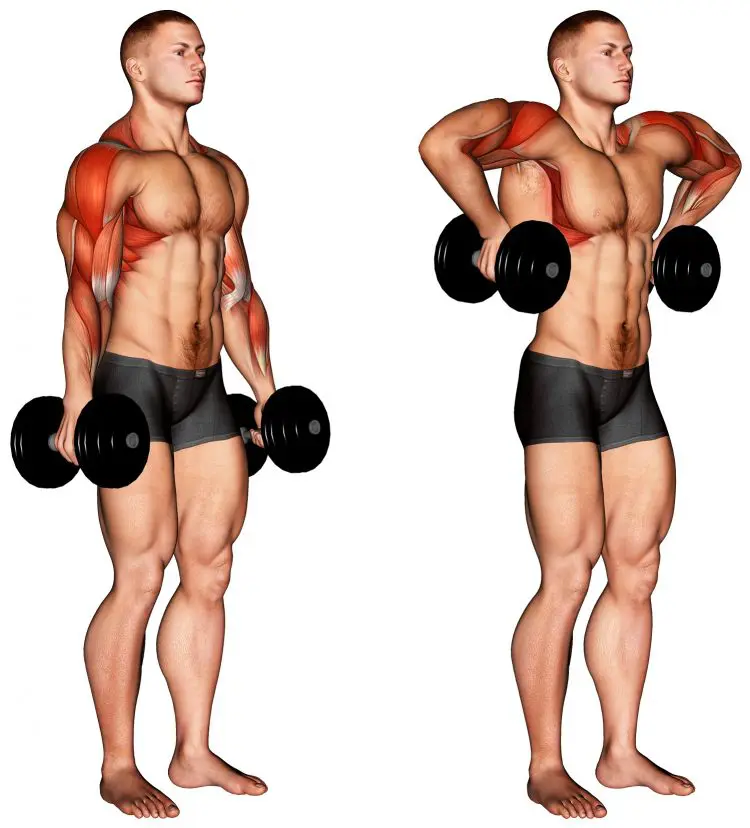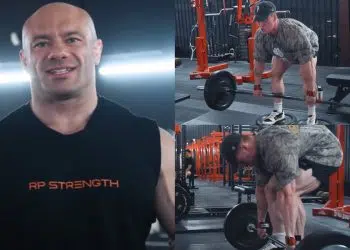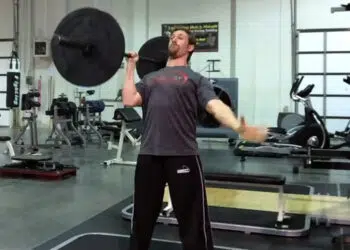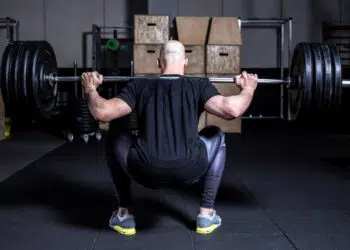Do you want wider, more impressive deltoids? Consider including the dumbbell raise, also called the armpit row and monkey row, in your shoulder training routine. This variation involves raising dumbbells up along your torso to activate the lateral or outer portion of the shoulders.
It’s not your conventional later raise but we have a feeling you’ll it because it keeps shoulder training interesting.
Follow along to learn more about this exercise including how to do it with tips, variations, and how to include it in your training.
Muscles Worked
While the delts is the muscle we’re after, there are several more involved in dumbbell raises. Here’s a list of all the muscles, where they’re located and what they do.
Deltoid lateral
The lateral or outer deltoids give that rounded scoop to the shoulder muscles. It’s the lateral most head that makes it possible for us to abduct the arms away from the body laterally between a specific 15-100 degree angle.
Deltoid posterior
If you start from the lateral deltoids and wrap around the back of your shoulders you’ll fine the deltoid posterior also known as the rear delts. While the front delts contribute to forward arm movement, the posterior head does the opposite to pull the shoulder blades back with assistance from other muscles.
Level Up Your Fitness: Join our 💪 strong community in Fitness Volt Newsletter. Get daily inspiration, expert-backed workouts, nutrition tips, the latest in strength sports, and the support you need to reach your goals. Subscribe for free!
Biceps brachii
A twin muscle, the biceps brachii has two heads on the anterior upper arm that when flexed create a ball-like appearance. Anatomically, our biceps muscles cross both the elbow and shoulder joint although it’s function is stronger at the elbow which is flexion of the arm and rotation of the forearm in either direction.
Brachialis
The king elbow flexors, brachialis is a key muscle in similar movements. It’s found in the upper and lower arm also contributing to twisting the forearms to either a palms up or palms down position.
Brachioradialis
Not an area of focus, the brachioradialis lateral forearm muscles give aid to the brachialis and biceps in the process of elbow flexion.
Trapezius upper fibers
You could consider dumbbell raises a form of shrugs and therefore you can hit the traps pretty hard with this exercise. The trapezius muscles are split into three segments – Lower, middle and upper fibers. Not surprisingly, the upper fibers contribute to vertical scapular movement while the middle fibers move the scap back and the lower muscles bring it down toward the floor.
Shrugs are the most popular exercise for targeting this muscle group but you’ll feel them during dumbbell raises.
How To Do The Dumbbell Raise
Here are step-by-step instructions.
- Grab two dumbbells and relax your arms by your sides.
- Using a neutral grip, hinge forward slightly and pull the dumbbells up into your armpits while keeping your elbows back and squeezing the upper back muscles.
- Lower the dumbbells back down and repeat for the desired number of reps.
Here’s an example video…
Dumbbell Raise Tips
- If you’re a beginner, use the lightest dumbbells possible and do higher reps. Focus on activating your delts and upper back muscles.
- Make sure to pull the dumbbells into the armpits and squeeze the upper back muscles.
- This is an exercise that can be done safely and effectively using heavy weights.
- Avoid swinging your body to get the weight up unless you’re more advanced and performing cheat repetitions.
- If you feel joint pain, stop the exercise. You might be using too much weight. Do not continue if the pain persists consistently even after lightening up the weight. You may need to seek help from a medical professional as shoulder pain is nothing to take lightly.
Dumbbell Raise Variations / Alternatives
Here are three very effective variations/alternatives that we recommend.
1. Shrug
Shrugs are a time-tested exercise that builds huge traps and upper back muscles and also works the deltoids.
Level Up Your Fitness: Join our 💪 strong community in Fitness Volt Newsletter. Get daily inspiration, expert-backed workouts, nutrition tips, the latest in strength sports, and the support you need to reach your goals. Subscribe for free!
Instead of pulling the weights up like with the dumbbell raise, you elevate the shoulders to activate the upper back muscles.
When you do shrugs, raise your elbows to get a more pronounced contraction in the traps.
2. Cable/band raise
You can also use cables or resistance bands to do this exact exercise. This is especially a good alternative if you don’t have dumbbells but even if you did, there are benefits to using both as long as you can implement progressive overload.
3. Lateral raise
The lateral shoulder raise and all of its variations are a must if you’re going to maximize your delts development. And, of course, your traps and upper back muscles get some work too.
You can do this movement so many different ways and it’ll no doubt slap size and roundness onto your upper body.
Related: Best Side Delt Exercises for Broader, More Powerful Shoulders
How To Incorporate The Dumbbell Raise Into Your Training Routine
We recommend including the dumbbell raise and its variations in your shoulder workouts at least once per week. We know shoulder presses are the primary go-to exercise for building muscular shoulders but you need a lateral raise variation to further emphasize the side delts.
A good example shoulder workout would include a front raise (optional as it’s heavily involved in all pressing exercises), a lateral raise, and a rear delt raise of some sort.
Also read: 15 Best Overhead Barbell Press Variations for Big, Powerful Shoulders
Sets/reps
How many sets and reps will depend on your experience level and exercise routine. But in general, we recommend at least 3 sets of anywhere from 8-20 reps.
The weight used should vary between workouts as some days you can go heavier, and on others, you can train lighter with more reps. Both are very effective for building impressive shoulder muscles and strength.
This isn’t set in stone but just a suggestion.
Wrapping Up
The dumbbell raise is an unconventional yet effective exercise that you can do to build your deltoid lateral muscles. It gives nice width to the upper body and can make your waist look smaller too.
Don’t forget about the variations and alternatives too as it’s always good to mix things up for maximum gains!
Interested in measuring your progress? Check out our strength standards for Shoulder Press.












